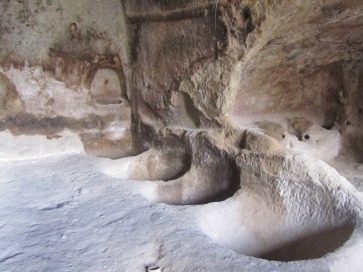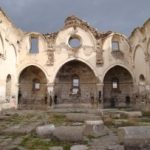Amongst Cappadocia‘s many fascinating attractions some of the most astounding are the “underground cities” with which the area is riddled. These structures are both well-known and at the same time extremely mysterious because almost no written records have survived to provide information about their purpose.
It was the Greek historian Xenophon who provided the first mention of them in a short passage in his Anabasis written in the fourth century BC. However, most archaeologists assume that at least the upper levels of the “cities” had already been in existence for many centuries by the time Xenophon passed through. In their opinion, it was the Hittites who probably started the business of hollowing out the Cappadocian soil, even though so far no Hittite artefacts have been found to confirm their beliefs.
The underground cities consist of networks of tunnels and caves that spiral down inside the earth – in the case of Derinkuyu (“deep well”) to a depth of eight levels beneath the surface. However, as anyone who has ever actually been inside one of these labyrinths will know, it is hard to hold on to any sense of the layering once you get below the first level. Instead you find yourself wandering, at times bent double, through an assortment of tunnels which open out every now and again into cave rooms of varying sizes.
The functions of these rooms have been identified according to the assumed uses of the niches and holes cut into them. In determining these uses, historians have had to make assumptions based on what similar niches and holes are used for in the still-inhabited cave homes of present-day Cappadocia.
Extrapolating backwards, they have identified larger niches in the upper levels as mangers for feeding animals. Small circular holes in the ground are assumed to have supported amphora-like pots used as kitchen storage jars. Pits in the floor probably served as tandır ovens for cooking and heating while smaller niches high up in the walls would have held candles. Finally, larger indentations in the floor are assumed to have been used for treading grapes to make wine.
Strangely enough, the archaeologists have been unable to identify any toilets at Derinkuyu. Indeed, the only underground city which does have a clearly unidentifiable toilet is one of the two in Güzelyurt.
Xenophon write that the villagers stabled their animals and stored their foodstuffs underground but he was most excited about the large jars of beer he saw there. This potent liquid was, he said, mixed with water and then drunk through straws.
However, he had nothing to say about the huge rolling-stone doors that most impress modern visitors. These circular stones seem to have been carved out in situ and could be rolled across the tunnels with the help of wooden levers to prevent enemies entering.
Although the networks of tunnels are always called “underground cities”, this is a bit of a misnomer since it suggests that people lived permanently underground. But such a life would always have been extremely unpleasant, if even possible. Even today, with back-up generators for when the electricity snaps off and arrows to mark the entrances and exits, it’s all too easy to become disoriented and many people find the tunnels claustrophobic. The deep wells and ventilation shafts may be impressive to look at and the holes that make it possible to yell from one floor to another may make communication easier but it’s unlikely that people would have wanted to spend any more time down here than was strictly necessary. Instead they probably took refuge underground for short periods of time when feeling threatened.
The tunnels were probably at their busiest from the seventh to the 11th centuries when local Christians would have wanted to hide from bands of marauding Arab invaders. Certainly, the finds that have been made in the underground cities all date from the Byzantine period. The last recorded use of an underground city for protection was in 1832 when residents of Derinkuyu ducked below ground to hide from the troops of the Egyptian leader, İbrahim Pasa. However, the British archaeologist, Richard MacGillivray Dawkins, reported that Christians in Derinkuyu had retreated into the underground cities again in 1909 after hearing about the massacres of Armenians around Adana.
 The underground city in Sinan’s birthplace of Ağırnas, near KayseriIn high summer the most visited underground sities at Derinkuyu and Kaymaklı can be uncomfortably crowded which is a shame since they are the easiest for those without private transport to reach by bus from Nevşehir or Niğde. The so-called underground city discovered at Nevşehir in 2013 is really a collection of caves hollowed out beneath houses on the hillside.
The underground city in Sinan’s birthplace of Ağırnas, near KayseriIn high summer the most visited underground sities at Derinkuyu and Kaymaklı can be uncomfortably crowded which is a shame since they are the easiest for those without private transport to reach by bus from Nevşehir or Niğde. The so-called underground city discovered at Nevşehir in 2013 is really a collection of caves hollowed out beneath houses on the hillside.
For those who want to escape the crowds the following are possible alternatives. Not all of them are always open to the public.
Özluce
Mazi
Tatların


